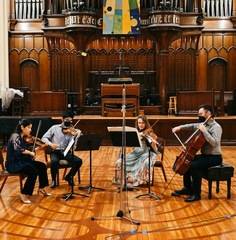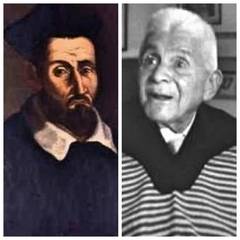|
Back
From Theory to Delight New York
Americas Society
10/04/2023 -
Pietro Cerone: El melopeo y maestro: “Enigma de la escala” (Realization by Sebastián Zubieta)
Arun Ramamurthy & Trina Basu: Hemvathi
Julián Carrillo: String Quartet No. 12
Robert Morris: Carnatic String Quartet
Momenta Quartet: Emilie-Anne Gendron, Alex Shiozaki (Violins), Stephanie Griffin (Viola), Michael Haas (Cello); Arun Ramamurthy, Trina Bas (Guest violins)

Momenta Quartet (© John Gurrin)
“While the treatise of Pietro Cerone shows that he possessed considerable compositional skill, no music by Cerone has survived and he is not known to have published any.”
From Wikipedia
“The world by day is like European music; a flowing concourse of vast harmony, composed of concord and discord and many disconnected fragments. And the night world is our Indian music; one pure, deep and tender raga.”
Rabindranath Tagore
The jeu de mots subtitle for this concert by the amazing Momenta Quartet says it all.
“Momenta à La Mode” encompassed music over 500 years, from 1603 to 2023. Yet every work included variations on modal scales. The 17th Century archaic modes of one Pietro Cerone. (Yet he only wrote about them, not bothering to compose). The work for two violins and viola, Hemavathi started with Indian modes–but with some kind of music magic, it morphed into jazz and classical improvisation.
The great–and today almost unknown Mexican–composer Julián Carrillo fooled around with microtones with elongated scales. Yet he used a single theme over four movements turning and twisting and playing games, having instrumental conversations, Carrillo could have been writing one of those medieval pieces with symbolic pictures (a Cross? Christmas tree?) right on the score.
Finally we came to the last work, Robert Morris’, who was present at the concert. He wrote his Carnatic String Quartet–almost an hour long–-with 70, or 80 or 90 different ragas, yet his last movement surveyed all the Gregorian modes. Disguised, animated, singing and selecting. Yet all in an eclectic structure which breathed ancient and new together.
Still, all this was grist–or Beluga caviar–for these players. Unlike the early Kronos, who restricted themselves to the new and the exotic, Momenta reaches to the earliest music, or Schubert, or explore–as they did in Hemivathi–musics from around the world. Their expertise is unparalleled, and their explorations are fascinating.
Did I say that the theme was modal music? That was half the concept. The other was the sheer playfulness, at times friskiness of the music. Though the original inspirations may have been more serious.
In Mr. Morris’ Carnatic Quartet, based partly on the music of Kerala in south India, this animation was enshrouded in explanatory program notes which were–to say the least–both discouraging and intimidating. I won’t you with phrases like “The first movement Raghupriya”. Or “a free rhythmic form of heterophonic counterpoint.” You get the idea.
I’m certain this was followed to the letter (or the notes). But to the unwashed initiate, this was music which swayed together in the opening movement. The Quartet played the complex rhythms with sureness and clarity? Was it long? Yes, but Mr. Morris allowed the ensembles to juggle the lines and, yes, tunes.
The second movement was more “exotic” (Arabic rather than the titular Kerala music), but this was secondary to the singing of each instrument. Mainly they were in the higher registers, on the cusp of the avian, but always controlled. That third movement was equally luminous. Mr. Morris had written that all the old Gregorian modes were used. But so complex, so involved was the language, that they were happily confined. Like Elliott Carter’s chamber music, the theory and intricacy were worthy of many a tome. The results, though, were those of sheer vitality.

P. Cerone/J. Carrillo
The Momenta Quartet has taken up the cause of Julián Carrillo for good reason. I was unfamiliar with his music and looked askance at his reputation in using microtones. Too often do these artifices sound like chalk on blackboard. How would Carillo eschew those sounds?
Very simply. With pure vigor. Starting with a consonant theme, which would continue through all four movements, he wrote with such a deft alacrity, that the microtomic sounds made less for “bad tuning” than sheer resonance.
With their second movement dancing quirky scherzo, an image immediately came to mind. Had Felix Mendelssohn been Mexican, living n 1964, this would have been his music. Including eight bars of (ironic?) pure Beethovenian majesty. Then back to the fun.
The quartet muted their instruments for the third movement, which indeed started with chthonic darkness. That segued into a series of night-music calls. And the last movement was a reprise of all the preceding delights.
I mentioned that Momenta’s clarity and color. Yet they had another dimension. Like Jean‑Philippe Rameau later in the 18th Century, Italian-Spanish Pietro Cerone was known as one of the great theorists of music. Rameau of course made theory practicality with thousands of compositions. Cerone was devoid of inspiration.
Still one of his printed examples, this of a scale, was “realized” by Sebastián Zubieta, the Brazilian-born director of New York’s America Society. In about six minutes the Momenta Quartet played music with the complexity of Robert Morris, but with any of the animation. Most telling was the transformations of the artists. This was music played like a consort of dark‑hued viols. A scholarly opening to what would become an evening glittering unexpected joy.
Harry Rolnick
|